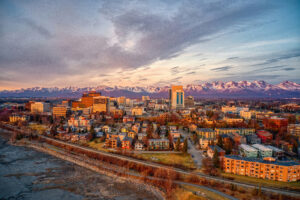
Aerial View of a Sunset over Downtown Anchorage, Alaska in Spring
I have recently learned that the U.S. Census Bureau classifies Anchorage(MOA) and the Mat-Su together as a metropolitan statistical area (MSA). MSAs are areas with economic ties to the central area, as measured by commuting patterns. Currently, there are 57,000 vehicles per day that leave Anchorage heading north with exits to Eagle River, Chugiak, Palmer, Wasilla and all the way to Chase, Alaska with a population of 19 in 2020 but the majority of vehicles head to the ‘Valley’ aka the Matu Su Borough. It has a population of 111,752 and 25,000 square miles compared to the MOA’s population of 281,810 and 1,961 square miles which makes the MOA’s land base only 7.8 percent of the Mat-Su’s. I share this with you because the MSA vs. MOA is an important distinction when analyzing residential inventory and where it is built and what Anchorage as a ‘ hometown’ is competing against. The March 2023 ‘Alaska Economic Trends’ reports that Anchorage’s recent population loss of 12,000 was, therefore, not a loss for the MSA because 5,000 moved to the Valley. However, Anchorage’s loss has had a significant negative impact on Anchorage’s school population and created a negative impression of our community.

 Connie Yoshimura is the Owner and Broker of Berkshire Hathaway HomeServices Alaska Realty. With over 40 years of residential real estate experience, she continues to be a leader in Alaska’s housing market. Most recently, she sold the highest-priced home ever recorded in the Alaska MLS.
Connie Yoshimura is the Owner and Broker of Berkshire Hathaway HomeServices Alaska Realty. With over 40 years of residential real estate experience, she continues to be a leader in Alaska’s housing market. Most recently, she sold the highest-priced home ever recorded in the Alaska MLS.
Leave a Reply